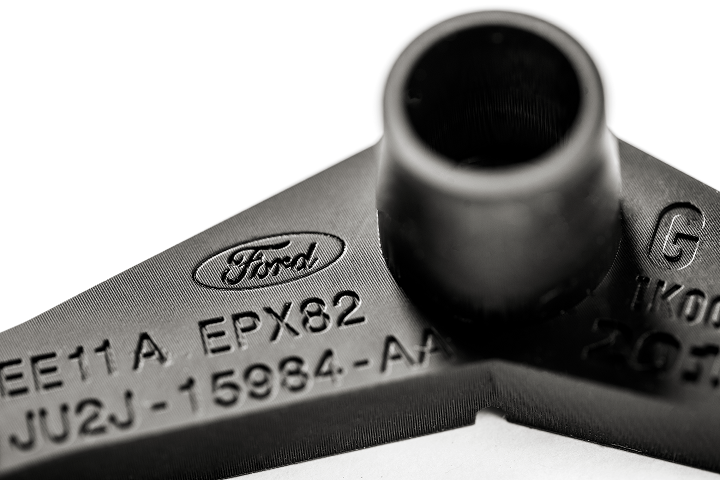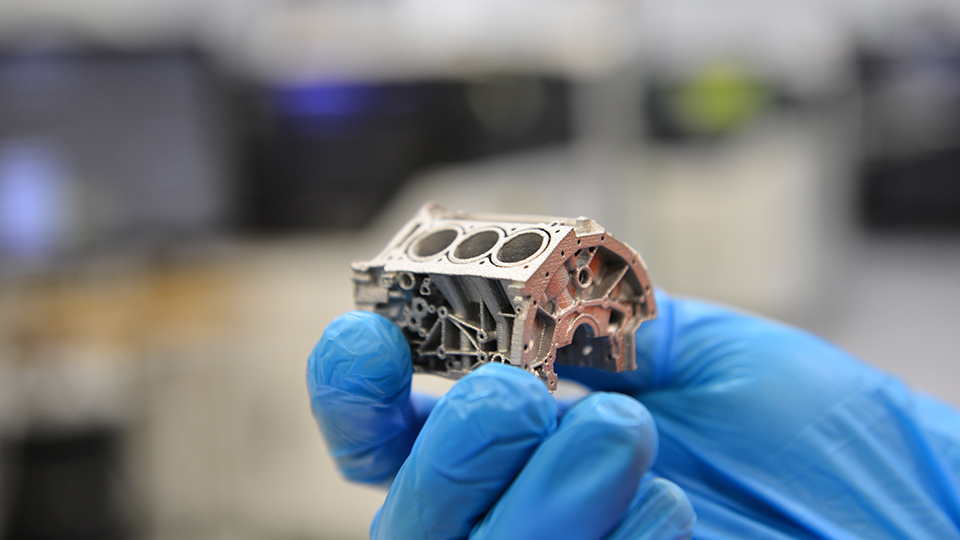Ford Motor Company (NYSE: F) has made it public that it will be mass producing a new automotive component with metal 3D printing in the next two to three years. Specifically, the AM technical leader for Ford, Harold Sears, said that it will be relying on metal binder jetting from ExOne (Nasdaq: XONE) to move to full-scale production of the end part. As it perfects the process of mass producing this item, it plans to expand the technology to other parts.
Ford has long used 3D printing, first relying on the technology for prototyping and later becoming an early adopter and development partner for cutting edge processes, such as Digital Light Synthesis from Carbon. It’s no surprise then that it would be a leader in the use of additive manufacturing (AM) for metal end parts.

Parts Ford has 3D printed using Digital Light Synthesis for specialty vehicles. Image courtesy of Carbon.
The key to the development was a recent achievement with ExOne to 3D print aluminum 6061 with physical properties comparable to die cast components. The ability to 3D print and sinter the metal in a repeatable manner has made Ford “confident that additive manufacturing is scalable to volumes that support automotive,” according to Sears.
Though Sears did not specify which part would be made for what vehicle—except that it is “a very popular model” of Ford vehicle—he noted that it will have reduced weight and size, as well as enhanced performance and lower cost and production time due to reduced complexity in terms of assembly. This suggests that multiple components may be consolidated into a single item. “We found an application where design for additive manufacturing is just a perfect fit,” Sears said.
Ford turned to binder jet due to issues inherent with laser powder bed fusion (LPBF). It tested the use of LPBF with aluminum but found support structures to be challenging. In contrast, binder jet can produce large batches of parts with post-processing technology that is already standard in metal injection molding. The only issue was that no aluminum material was available for their application.
Because ExOne was already developing aluminum, it worked with Ford to speed up the process and, a year-and-a-half later, they had achieved their goal. In fact, they were able to go beyond simply readying the metal for binder jetting, they’d also refined post-processing for the technology to achieve the necessary part properties.
The next step is to finalize development of the part itself. This would, in turn, lead to other applications for the company.
“High-speed aluminum 3D printing paves the way for other opportunities that we’re just now starting to take a look at because of the ability to do complex parts with aluminum that previously weren’t possible. It’s really opening doors for other opportunities,” Sears said.
Interestingly, this news comes shortly after Volkswagen announced that it would be 3D printing an end part for the upcoming T-Roc convertible. The technology of choice is Metal Jet, HP’s take on metal binder jetting. VW aims to produce some 100,000 components annually by 2025 using the process and is now testing the T-Roc part.
If these two auto giants are going public about their use of metal 3D printing for end part production, we can only assume that they’re the tip of the iceberg. Soon enough, other competitors in the field will be revealing their uses of AM for end parts and, hey, maybe you’ll find a 3D printed component on your next, new car.
Subscribe to Our Email Newsletter
Stay up-to-date on all the latest news from the 3D printing industry and receive information and offers from third party vendors.
Print Services
Upload your 3D Models and get them printed quickly and efficiently.
You May Also Like
3D Printing News Briefs, June 11, 2025: Sustainability, Automotive Tooling, & More
We’re starting with sustainability news in today’s 3D Printing News Briefs, as EOS has strengthened its commitment on climate responsibility, and Zestep is making 3D printing filament out of eyewear...
3D Printing 50 Polymer Stand-In Parts for Tokamaks at the PPPL & Elytt Energy
Of all the world’s things, a tokamak is one of the hardest, most complex, expensive and exacting ones to make. These fusion energy devices make plasma, and use magnets to...
3D Printing News Briefs, May 17, 2025: Color-Changing Materials, Humanoid Robot, & More
We’re covering research innovations in today’s 3D Printing News Briefs! First, Penn Engineering developed 3D printed materials that change color under stress, and UC Berkeley researchers created an open source,...
Firehawk Aerospace Partners with JuggerBot 3D, Gets $1.25M from AFWERX for 3D Printed Propellants
Texas-based Firehawk Aerospace, an advanced energetic materials firm that works with aerospace and defense applications, announced a strategic partnership with JuggerBot 3D, an Ohio-based large-format 3D printer manufacturer. Together, the...


































